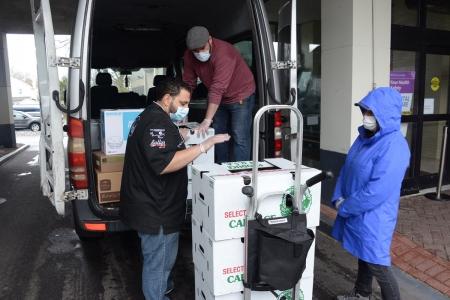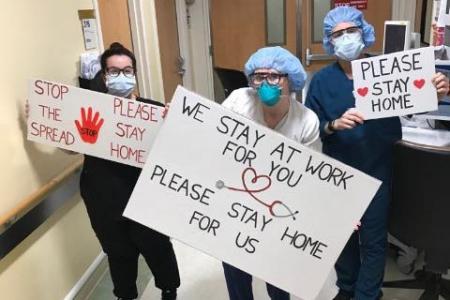Federation of Nurses/UFT members on the front lines of the coronavirus battle are finding strength in each other and in their union at NYU Langone Hospital–Brooklyn and at Staten Island University Hospital South.
“This is a war and our hospitals are the battlefields,” said UFT Vice President Anne Goldman, who is the head of the Federation of Nurses/UFT. “Every day is a challenge, but we intend to defeat this insidious enemy.”
Nancy Barth Miller, the UFT chapter leader at Staten Island University Hospital South, part of the Northwell Health system, said nurses are being called “heroes without capes.”
And for a while, they were also without crucial personal protective equipment. But at both hospitals, staff is now properly outfitted, thanks to the UFT’s advocacy and its cooperation with both hospital administrations.
The UFT also is delivering 1,000 individually wrapped meals to nurses on all three shifts at the hospitals on Tuesdays, Thursdays and Saturdays. The UFT Disaster Relief Fund on March 27 began collecting donations to pay for the initiative. By Day 3, 400 members had contributed nearly $17,000 in total.
Donate to the UFT Disaster Relief Fund
“It looks like a war zone at times, especially if you’re taking care of a positive patient on a ventilator,” said Miller, a nurse for nearly 40 years “Everybody is garbed from head to toe in gowns, helmets with plastic face shields, goggles, hair nets, gloves and N95 respirators, which offer protection from airborne particles.”
Goldman and Miller regularly confer with Northwell executives to discuss concerns and advocate for equipment. Miller informs the nurses about new protocols or issues either in person or through her blog.
Howard Sandau, a critical care/emergency room nurse and a special representative for the UFT, met with executives at NYU Langone-Brooklyn recently to ensure equipment was getting where it needed to be.
“The biggest stress was the way they were delivering supplies,” said Sandau. “They’re trying to be careful and conserve because they are predicting the next several weeks to be very, very bad.”
He advocated to hospital officials that personal protective equipment be sent to higher risk areas “where the most critical patients are because the nurses are in this environment every second of every shift.” A few days later, Sandau said, new equipment was arriving every four hours to these areas.
The risk of transmission is higher, Miller explained, for nurses who work with seriously ill patients with pneumonia who are on ventilators. “Once they’re on the ventilator, you’re cleaning out their mouths, you’re suctioning,” she said.
Sandau recently worked four consecutive 12-hour shifts in an ICU at the NYU Langone–Brooklyn. “It’s very scary because we don’t know what’s going on with this virus. Nobody has really figured it out,” Sandau said. “We’re just trying to save people by treating their symptoms."
The nurses report day after day despite the personal risks. “A lot of them are young, they have families, and they’re worried about bringing something home to their children,” he said.
Sandau puts his hospital scrubs into a garbage bag at the end of his shift and washes them immediately when he gets home. Everything that can’t be washed gets wiped down with bleach.
Miller says the work is both physically and mentally exhausting.
“I do think down the line it will take its toll because you do everything you can, you care for these people, and then they die,” she said. “We have to think about what we are going to do for these nurses who have been in the trenches to keep them whole.”
At both hospitals, staff is being redeployed according to skill set as nonemergency services are shut down and more and more units are converted to intensive care.
“We have so many patients, they are everywhere,” Sandau said.
NYU Langone created a respiratory assessment center next door for anyone who arrives with fever at the hospital.
“There is a lot of fear in the community,” Sandau said. “People were overwhelming the ER and opening this center has helped dramatically.”
Morale among nurses is good, Miller says. “They are extremely dedicated. Everybody is reporting to work; the sick calls are very limited. They come in with a smile on their face, help anyone who needs anything and give it their best.”
But she wonders if the nurses will be able to keep up their spirits indefinitely.
“I don’t know how long that will last because it’s so so sad — people are dying alone in their rooms. And I don’t think we’ve even gotten up the hill yet.”
The mood is the same in Brooklyn. “The nurses are supporting each other and doing the best we can,” Sandau said. “But it seems like an impossible situation. There are so many very critically ill patients constantly requiring intensive care.”
But their mission drives the nurses.
“We take an oath to be there for the public,” he said. “That’s why I became a nurse and that’s why I’m doing what I can.”
And for the public, Sandau has a message: “Take the social distancing seriously so we don’t overwhelm the hospitals.”

